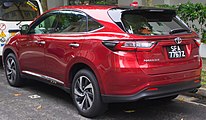Toyota Harrier
| Toyota Harrier | |
|---|---|
| Production period: | since 1997 |
| Class : | SUV |
| Body versions : | Station wagon |
The Toyota Harrier is a sports utility vehicle produced by the Japanese car manufacturer Toyota since December 1997 . While the first two of the three generations produced so far are identical to the Lexus RX , the third generation currently on offer is an independent model.
The vehicle is named after the bird genus of the consecration ( in English: "harrier" ). For this reason, the logo on the grill does not show the Toyota brand emblem, but the head of a bird.
Identical models to the Lexus RX
Since the premium brand Lexus had not yet been introduced when the RX was launched in Japan, the vehicle was initially sold on the domestic market under the brand name Toyota. In 2006, Toyota finally introduced the independent Lexus brand in Japan. The third RX generation presented at the end of 2008 was therefore no longer sold as a Toyota, but also as a Lexus in Japan. The second generation Harrier was sold as Toyota in Japan until 2013.
Standalone models
XU60 (since 2013)
| 3rd generation | |
|---|---|
|
Toyota Harrier (2013-2017) |
|
| Production period: | since 2013 |
| Body versions : | Station wagon |
| Engines: |
Petrol engine : 2.0 liters (111–170 kW) Otto hybrid : 2.5 liters (145 kW) |
| Length: | 4725-4770 mm |
| Width: | 1835 mm |
| Height: | 1665-1690 mm |
| Wheelbase : | 2660 mm |
| Empty weight : | 1590-1840 kg |
On December 2, 2013, Toyota introduced the third generation of the Harrier in Japan with a 111 kW (151 PS) two-liter gasoline engine . The hybrid variant with the drive from the Lexus NX followed on January 15, 2014. In contrast to the third RX generation, which is based on the Camry platform, the third generation of the Harrier is based on the new MC platform of the Toyota RAV4 .
The Harrier received a facelift in June 2017. In addition to some visual revisions, the turbocharged two-liter gasoline engine was introduced from the Lexus NX 200t. In the Harrier it does a little less with 170 kW (231 hp). The SUV has also been officially sold by Toyota in Singapore since then . The Harrier had previously been successfully sold there by various importers. The vehicle has also been available in Malaysia since November 2017 .
Technical specifications
| 2.0 1 | 2.0 turbo 2 | 2.5 Hybrid 1 | |
|---|---|---|---|
| Construction period | since 12/2013 | since 06/2017 | since 01/2014 |
| Engine characteristics | |||
| Engine type and number of cylinders |
R4 petrol engine | R4 petrol engine + electric motor | |
| Displacement | 1986 cc | 1998 cc | 2493 cc |
| Internal combustion engine power | 111 kW (151 PS) at 6100 | 170 kW (231 hp) at 5200-5600 | 112 kW (152 hp) at 5700 |
| Electric motor power front axle |
- | 105 kW (143 hp) | |
| Electric motor power rear axle |
- | 50 kW (68 hp) | |
| System performance | - | 145 kW (197 hp) | |
| Max. Torque | 193 Nm at 3800 | 350 Nm at 1650-4000 | 206 Nm at 4400-4800 |
| Power transmission | |||
| Drive, as standard | Front wheel drive | all wheel drive | |
| Drive, optional | all wheel drive | - | |
| transmission | Stepless transmission | 6-speed automatic transmission | Stepless transmission |
| Readings | |||
| Top speed | 180 km / h | ||
| Acceleration 0-100 km / h |
7.3 s | ||
| Fuel consumption over 100 km (in accordance with the EEC directive, combined) |
7.6 l super | ||
| CO 2 emissions, combined | 145 g / km | 177 g / km | 108 g / km |
| Tank capacity | 60 l | 56 l | |
Individual evidence
- ↑ Redesigned Toyota 'Harrier' Crossover SUV to Launch in Japan . November 13, 2013. Retrieved October 1, 2017.
- ↑ Toyota Harrier facelift makes Japan debut - 2.0 turbo; Singapore to get it as official import, Malaysia next? . June 13, 2017. Retrieved October 1, 2017.
- ↑ Toyota Harrier 2.0 Premium review: Mine is Harrier than yours . July 22, 2017. Retrieved October 1, 2017.
- ↑ Officially Imported 2018 Toyota Harrier Now In Malaysia - From RM238,000, Tentative Full Specs Here . November 9, 2017. Retrieved December 2, 2017.






